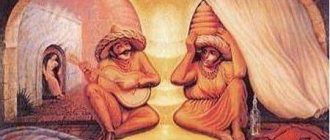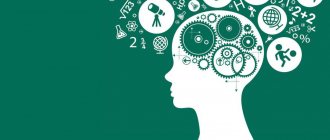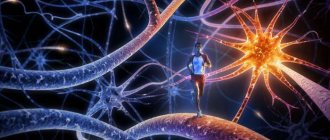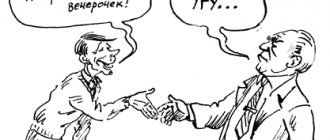Direct and indirect perception
Perception is the ability of living organisms (to see, hear, touch, taste and smell). The process of mastering new knowledge, skills and abilities always involves a path from direct observation (external vision) of an object to generalization (awareness, knowledge) of its structure, and then only to practice.
When starting to do something, learning something, a person usually copies and repeats what is visible (a person receives 70% of information through the visual channel of perception, regardless of further processing of the information received).
An artist copies a painting, a dancer and fighter - movements, a singer - the voice of a good singer, etc. But still they do not achieve what we see in museums and hear in good concert halls. What's behind this?
Firstly, we need a school (system of techniques) that allows us to master this type of activity, and secondly, at the first stage, a person always monitors (perceives) only clearly expressed actions, picks up rough vibrations that are in no way combined and do not correspond to genuine ones ( outwardly subtle) vibrations.
Although the path of imitating the external manifestations of an object provides some useful experience and results, one must be wary of complete internal identification with the mask being tried on: sometimes people even lose their self-identity behind many masks.
Perception is, as already mentioned, a property of a person, his ability to receive direct impressions. But looking at something new, never seen before, we gradually begin to recognize it. a grid of recognition over it
. After the grid is cast, the work of the mind (mediated perception) begins.
As long as something is not recognized or indirectly perceived, we can recognize anything in it and perceive it freely. Why is indirect perception dangerous? Once a phenomenon is recognized, a person already “knows” how to deal with this phenomenon. He makes a cast of it and “puts it on the shelf.”
The image of the world is what a person was able to perceive from this world. As a result, for most people the world becomes double. Double macro- and microcosm, which flow into each other.
As soon as we begin to directly perceive the world, our immediate image gradually unfolds and is drawn. It automatically exists for us as a ready-made, logical model of the world. Direct (based on direct perception) and indirect (logical) models of the universe are always connected and always mirrored.
If a person’s mind rejects the fact that there are extrasensory influences in the world, then they will not be perceived by him.
He doesn't have it in his head. He may hear about it, but if he himself is not internally (indirectly) convinced of it, then admitting that it exists is impossible for him. And vice versa, if a person actually did something like that or came under some kind of influence, then he will already recognize the unusual. His image of the world already includes this phenomenon. And this is present for him in the world.
Thus, the image of the world is not what a person claims as his knowledge about the world. On the contrary, the image of the world constantly tells a person what to do.
Vision and knowledge
The old people saw this world differently than we see it today. What is the reason? I am a supporter of the idea that old people saw the world as it was. Instead of the world, we see an illusion. In Russian it's called morok. We are all, as a rule, children of materialism, and we firmly believe that if something can be touched, then it is real.
Then it’s worth remembering how many times in a dream each of us “really” touched and felt something? And at the same time I did not realize that it was only in a dream. For the sleeper, everything was real. Even more real sensations are possible with hallucinations and fainting! All this, however, does not mean that there is nothing material behind the illusion. It is.
Behind the recognition of one's own hand there is the hand itself. Another thing is what does a person see? A hand or something he perceives as a hand? The obvious is deeply deceptive. It is because of it that we are deprived of the present, the essence of phenomena. Cause? We replace the spiritual vision of the world, or, in other words, knowledge (knowledge) with vision.
The obvious is what you see with your eyes.
We make casts with our external vision, and these casts (images) are now with us for the rest of our lives, they replace our knowledge about the world. You will recognize not the real world, but a picture: a set of qualities.
Coming into this world as a being capable of only external perception, you begin to absorb it (the world) in the form of encoded information (in the form of images) and create a pseudo-integrated picture of the world from these images.
Why can't we enter the real world without images of recognition? Why do we live in a world of illusions? Why don't we allow ourselves to see the essence of things? Because if we get rid of our thinking patterns, we will face the unknown. We cannot allow ourselves to enter the true world without blinders, because then the world is unknown and it is not known what it will do to you now.
This is the main obstacle.
Chapter 4. THE SECOND SPIRITUAL DOUBLE OF MAN
According to various cultural traditions, the physical body of a person is clothed and located inside a kind of cocoon - the body of dreams. I consider the dream body as an analogue of the biofield (human energy drop). This body is felt in a relaxed state as pressure, as a force pulling the arms towards the body.
The energy of the dream body is used to kill, heal and perform other actions at the moment of falling asleep, when mortal danger arises and on the verge of death. Among the southern Slavs, the second spiritual double of a person was called vedogon
.
This is an invisible spirit that accompanies people from birth to death. It was believed that during sleep, the vedogon protects a person’s property from thieves, and his life from troubles or other vedogons. Therefore, these spirits often fight among themselves, and if a vedogon is killed in a fight, then the person, his master, will soon die.
When a double (vedogon) is released, a person stops thinking, he has the feeling that he begins to see his body from the outside. A double spirit (vedogon) can, under certain conditions, act as two different personalities at the same time.
The human biofield is an egg-shaped cocoon.
Its thickness in a healthy person is 40–60 cm; 30 cm indicates a serious imbalance in energy balance; when the field is depleted to 15–20 cm, the person loses consciousness. Very healthy people have a field of 1 m, while phenomena of 3 m or more are phenomenal. Diagnostics is carried out with a vine[48], a frame or hands - palms along the spine, i.e. along the energy centers.
The cocoon consists of three layers: etheric, astral and mental. If they separate from each other, then the person dies (Fig. 8).
Rice. 8. Three-layer structure of a human energy drop:
1 - etheric body; 2 - astral body; 3 - mental body
The etheric body is an exact copy of the physical body, but consists of more subtle matter (etheric double). The main purpose of this body is to preserve the forms of the physical body. The main background of its radiation is lilac-gray.
The astral body (the body of emotions) consists of even finer matter, the main background of its radiation is bluish-gray. The radiation of this body changes according to the person’s experiences according to the level of displacement of the collection point of perception. (We will talk more about TSV later.) The emotional body can separate from the physical body in an altered state of consciousness or in sleep.
The mental body is ovoid in shape and consists of the finest matter, forming a light sparkling bubble. Depending on the displacement of the TSV, the bubble changes color. These three bodies exist in more than three dimensions.
Inside the first cocoon there is a second eternal cocoon, this is the body of causality, which stores the experience of all rebirths.
The human biofield, therefore, is its most basic protection, first of all, from the harmful effects of other people.
We are very often exposed to this effect, and our field is greatly deformed by the end of the working day (we feel tired). Recovery requires rest.
From the middle of the cocoon, the man has rapidly rotating energy tendrils, or tentacles.
The surface of the cocoon is pointed towards the top and forms the tip of the spirit, which is responsible for intuitive knowledge of the world. This point is connected to the pineal gland[49] and serves as a link between man and the higher divine consciousness (Fig. 9).
Rice. 9. The second spiritual double (energy drop) of a man
A person lives in information and energy flows that he is able to perceive. For example, there are streams of fear, horror, violence, there are religious streams, there are streams of other worlds.
Each of these flows affects a person with the help of certain feelings, images, thoughts.
Often a person is a slave to the flows to which he is tuned. This happens because he is not able to rebuild his perception, to adjust himself to the perception of other flows.
Only by developing will (intention) and overcoming narcissism, stopping internal dialogue, will a person gain freedom.
Man is a dual being. It combines the actually human (cultural) and elemental (animal) principles.
This duality is evidenced, for example, by the functional asymmetry of the cerebral hemispheres, in which the right hemisphere of a person is responsible for an integral, imaginative human perception of reality, and the left hemisphere is responsible for a discrete, sequential (logical) one.
A person does not always harmoniously combine his logical and spontaneous essence. Often a discord arises between the mind and action in a person.
At the moment of strong emotional experiences, logic recedes into the background and the spontaneous principle comes out. Any parapsychological action is carried out at the expense of it. Therefore, it is necessary to learn how to “remove” order. This requires strict self-control, close attention to your thoughts, feelings, internal dialogue, i.e., acute perception is necessary.
By the influence of the will you can stop the internal dialogue and call the spontaneous outward. However, one must enter the elemental without crippling the logical. Otherwise the person may die.
Entering the information-energy flow, the noosphere of the Earth, each person, to the extent of his intellectual and, above all, spiritual level of development, gains the opportunity of close contact with the information field of his level (divine essence). This contact largely determines his life, or destiny.
A person thus combines three planes: physical, energetic and informational. Everything in the world is informational, including every particle that “makes up” a person. For example, to prevent kidney signals from being mixed with signals from other organs, they are transmitted through special channels in the body.
A network of such channels forms an energy frame - the structure of the so-called biologically active points on the skin. Irritation of points in certain systems can have a therapeutic effect.
From the ears, feet and irises of the eyes, energy channels go to all internal organs. Biologically active points and channels are responsible for ensuring that the influx of positive energy to the ears exceeds or is equal to the influx of negative energy to the feet.
The total energy influx of positive energy of the body at the crown of the head is approximately equal to the influx of negative energy at the soles. The general principle is based on the spiral of two lines, channels, descending and ascending at their intersection (Fig. 10).
Rice. 10. Normal circulation of energy throughout the body
The eyes are of particular importance for the information-energetic state of a person. Eyes are the information code of an individual on the physical plane of existence. At the same time, the eyes serve as a tunnel to another, subtle world: through the pupils, subtle energy flows in both directions. The power of gaze is an astral category. (The power of looking is equal to the power of thinking: with the help of thinking with the eyes you can do everything.)
The role of the minus is played by the shadow of a person. It is energetically connected to the body. The shadow is the absorption on the bottom plane. The shadow is two-dimensional, it has no height (thickness).
There are many beliefs associated with the shadow in various mystical and religious movements. In particular, the fact that a person’s shadow can be influenced in the same way as a living person. This can be attributed to both reflection and simply the image of a person. But the image will be a copy of the person, and the shadow and reflection are directly related to the person, but in essence are also a two-dimensional manifestation in our world.
In other words, it is a trace left by a person, and the trace always leads to its owner. Therefore, it is used in magical rituals. For this reason, some cultures recommend cutting off traces of yourself or erasing personal history so that no one can get close to the person. But on the other hand, it will still not be possible to completely eliminate your trace.
The shadow, as well as the reflection, together with a person are considered in connection with the other world. Or as the edge of the transition to the other world. It is no coincidence that all references in mystical writings and literature about the dead and ghosts come as descriptions of shadows and silhouettes.
Therefore, the shadow can be considered as a stabilizer, a balancer of a person in this three-dimensional world. A living person, just like a shadow in our world, does not have the opportunity to act independently, to manifest itself in the other world in full measure. Therefore, to act in that world, a person requires insufficient dimensionality, which will allow him to manifest himself as active in that world. Actions in that world, the world of shadows, are partly described in descriptions associated with dreams and fairy-tale epics.
By interacting with his biofield, a person is able to improve it. You can do this as follows.
You need to stand up, turn towards the sun, bend your arms at the elbows so that your palms are at shoulder level and turn them towards the sun.
Keep your fingers relaxed, slightly apart. You can “see” and feel air vibrations above your fingers. This is a sign of an influx of energy. The energy is collected in the solar plexus area and from there sent to the diseased organ.
During relaxation, subtle energy is intensively absorbed. When relaxing in the evening, it is useful to match the rhythm of energy centers (EC). Relaxation and rhythmization of the EC should not exceed 15 minutes. The rhythmization of the EC is carried out sequentially in the rhythm of the pulse. Each stage, therefore, should take no more than 2.5 minutes.
Stage 1. Chelo
- 15 pulse beats.
Stage 2. Throat
- 8 pulse beats.
Stage 3. Heart
- 5 pulse beats.
Stage 4. Yarlo
- 2 pulse beats.
Stage 5. Stomach
- 7 pulse beats.
Stage 6. Zarod
- own rhythm.
The entire universe is connected by a system of energy exchanges. Biorhythms depend on space.
The basic law of energy exchange is harmonic and sinusoidal (Fig. 11).
Rice. 11. Exchange of energies
At the moment the impulse passes through “0,” information windows are observed for 10–15 minutes, and all discoveries and insights occur at this moment.
You can bring a person’s energy to “0” and then he can be read like a book. If a person’s energy sign changes synchronously with the Sun, such a person is very harmonious with life. When the process of energy release is hampered, anomalies arise.
Solar oscillations are accompanied by colossal energy oscillations. The entire near space (from planets to molecules) is synchronized in its oscillations with the rhythm of solar respiration, but in antiphase with it, i.e. in half the period when the Sun emits energy, the entire near space absorbs it, in the other half of the period all consumers must give The sun has its share of energy. In nature there is a great fair law of energy exchange.
A person who is desynchronized with the Sun, in moments of release of energy tension, comes into a state of causeless irritation.
In addition to all that has been said, geopathogenic zones are an important external factor affecting health. They are formed by stripes of negative energy, a rather dense network covering the surface of the Earth.
Perceptual assemblage point
In this case, I turn to the theory of bioenergy fields and the doctrine according to which there are 48 bands of emanation (sounds) in the world: 40 bands make up the range of inorganic life (stones, water, unknown fields of inanimate energy), 7 – inorganic entities consisting of energy fields of life (spirits that are sensitive people) and one band is the range of animate energy that manifests itself in plants, insects, animals and people.
A person in his normal state reacts only to two ranges of emanation: his own (organic) and one of 40 inorganic (mineral), although he is capable of perceiving other ranges.
The human energy drop, which, as already mentioned, is the second spiritual double of a person, contains on its surface the so-called perception assembly point (PAP). Actually, TSV perceives emanations accessible to humans (repositories of memory and experience). The second spiritual double of a person thus consists of accumulated information and energy. After death, they disintegrate and dissolve into the world.
As a result, when being born again, a person does not remember anything that happened to him in past lives, but nevertheless this information is stored in him, forming a family memory, or an impulse ring.
So, the cocoon is capable of responding to all 48 bands of emanation present on Earth. It is divided into several lobes, like a tangerine. One of them, dividing the cocoon into two halves, is called the human stripe. On the right half of the cocoon there is a TSV, which records the emanations of people, animals, and plants.
To arbitrarily shift the TSV, a person needs enormous personal strength (strength of spirit). A slight movement of the TSV leads to a change in the internal state of a person. All our emotions, feelings, experiences are the result of TSV displacement. In humans, the TSV is located in the upper part of the right half of the cocoon, in animals and insects - in the lower part.
A shift of TSV to the right causes negative emotions, encourages violence, murder, and suffering. A shift to the left leads to positive emotions, manifestations of goodness, love, a shift of TSV upward introduces a person into cosmic consciousness, and a shift inside the cocoon - into the sublime (especially valuable).
Subjectively, we feel our TSV somewhere in the head area.
This is the center from which the ray of our attention emerges, perceiving external objects, feelings, thoughts. Thanks to TSV, we perceive ourselves and the world in one way or another.
In a child, TSV is not spatially fixed, but over time, due to upbringing, it is fixed. And then again, people of knowledge, have to learn to displace it.
Christ said: “You will not enter the kingdom of God until you become like children.” This means that while a person’s cocoon retains its personal form, it is difficult for him to master parapsychological abilities (telepathy, telekinesis, clairvoyance). Having lost its personal form, a cocoon, on the contrary, can very easily allow one to master all this, because its TSV is not strictly fixed.
Pulse ring
I understand the impulse ring as an analogue of family memory; it contains information accumulated by an individual in all his births. The impulse ring has a core (the core of the mind), around which energy clots of positive and negative experience, acquired by a given individual in one or another incarnation in the physical world, circulate in different orbits, like electrons around an atomic nucleus.
A person's impulse ring is located outside the person's physical body, that is, above the head in the dream body, and is preserved after his death. The entire biological part (body) of a person is served by the pulse ring with energy.
The field generated by the physical body serves as an energy bridge from the gross nature to the subtle energies of the pulse ring. We can say that an energy ring is a kind of energy plane created by the physical body of an individual. Therefore, a lot depends on the physical condition of a person.
Only information processed in the impulse ring becomes a conscious thought. Information from the structures of the brain enters the impulse ring, from where it returns to the brain as an already formed thought. Clumps of positive experience are located closest to the core. They “appear” in the pulse ring in a spherical (spherical) form. “Spheral” thoughts are more sublime and more complex than planar thoughts.
Accumulated planar thoughts fall only into the lower orbits of the impulse ring, which is why its potential weakens (Fig. 12).
Rice. 12. Human Pulse Ring
If an individual has only "low-orbit" thoughts, his high-quality essences may be lost.
A person is able to use three types of subtle energy: generated from the outside (from space); hereditary, which is received from ancestors at birth, is a generic force, it affects the duration of our life, obtained from food (food, water).
Under normal conditions, a person’s energy rises from the coccyx area (the fetus) up along the spinal column (the antenna that connects a person with the cosmos). At the level of the cervical vertebrae and throat, this flow splits into two, left and right, which in turn, along the sides, lower the energy down to the perineum area, and then rise up again (see Fig. 9).
This circulation is very important, and its damage leads to serious health problems. Typically, these disorders involve the formation of barriers to energy paths. As a result, where there is not enough energy, energy holes are formed. Radiculitis, osteochondrosis, and then migraine pain are consequences of energy deficiency.
In the area of energy holes, the vine begins to sense the curvature of the field at a great distance. The palms of the hands also feel this anomaly, like coldness and an unpleasant tingling sensation, up to the suction of the palm (advanced stage of cancer).
The energy level of the biofield is depleted mainly due to vampirism, often unconscious. Vampires are people of a self-centered nature. They cannot accumulate energy from space, so they are forced to feed off the energy of other people.
A vampire receives energy during conversations or other contacts with another person. Energy is usually collected through the eyes. Sensors can see how long energy tentacles appear from the energy center in the solar plexus area of the vampire and attach themselves to the weaker energy center of the victim.
Encounters with manifestations of evil never pass without leaving a trace for us. The evil eye, spell, curse as a targeted evil create strong energy vibrations. If a person concentrates his anger on someone, this vibration can pierce or damage the dream body. (Using a vine, you can identify this “hole.”) There will be an energetic protrusion on the back of the subtle body. The stronger a person is spiritually, the thicker and stronger the layer of his field protection. Then the field reflects evil.
In 1997, employees of the Department of Theoretical Problems of the RAI, under the leadership of P. P. Garyaev, conducted research to identify the effects of curse words on a living organism.
The researchers took seeds from the Arabidopsis plant. The results horrified scientists: verbal “treatment” of plant seeds with a curse was similar to irradiation with 40,000 roentgens. From such a shock dose, DNA chains and chromosomes broke, genes scattered and got mixed up. Most of the seeds died, and the genetic apparatus of the survivors began to develop unnatural programs - monstrous mutations began.
The result of the experiment did not depend on the volume of the spoken words: it was not caused by the strength of the sound, but by the strength of the word itself.
Studies have shown that the word greatly changes the structure of water, and adults are composed of approximately 70% of their body weight.
It turned out that water molecules under the influence of human speech can be arranged in complex ensembles, as a result of which the water itself can acquire the properties of poison. If you drink such “damned water” you can become seriously ill and even die.
Water conveys information well. Therefore, during feasts, they make toasts, as if programming, informing the drink, and then drink. They also say that the spirit of hop lives in strong drinks, and if you are in harmony with it, then your head will not hurt in the morning, so before drinking a glass, it is raised above eye level. Also, before eating food, especially in an unfamiliar place, the sign of the cross is placed on it to neutralize even accidental slander.
On the other hand, the group of P. P. Garyaev carried out experiments with kind words. Amazing result! Wheat grains that received 10,000 roentgens sprouted and began to develop normally. The healing power of kind words turned out to be so great. In turn, indifferent reading of texts gave zero effect.
A. N. Afanasyev writes that conspiracies “are not suitable for fun and, as monuments of a prophetic, magical word, they contain a terrible power that should not be tortured unless absolutely necessary; otherwise you'll get into trouble. Conspiracies therefore fell out of general use and became the subject of the secret knowledge of healers, sorcerers, healers and fortune tellers; People turn to them in cases when it is necessary to resort to the help of ancient spells. The mighty power of conspiracies lies precisely in well-known epic expressions, in formulas legalized since ancient times; As soon as the formulas are forgotten or changed, the spell is invalid. This conviction forced us to protect the very word of the conspiracy with special care, to preserve it as if it were a shrine.”[50]
Prayer, like conspiracy, refers to strong energy-power methods of influencing a person. It has a certain linguistic structure: organization of sentences, sound pronunciation, timbre of speech, sound strength and rhythm. In fact, this is a big topic, so I’ll limit myself to what has already been said.
Chapter 5. RECEIVING AND PROCESSING INFORMATION BY HUMAN
Based on the latest developments in the field of practical psychology, we will consider the leading representative systems of a person (each of us has our own), with the help of which a person receives, processes and transmits information.
We have already talked about the left and right hemispheres of the human brain and their functional asymmetry. Nevertheless, I will repeat.
The left hemisphere receives signs-markers for objects, actions, etc. The right hemisphere receives analogues, images. So, we can say that the left half of the body is more logical, responsible for the mind, and the right, more sensual, represents the realization of the subconscious.
If we take all the information entering the human brain as 100%, then 5% will be its logical processing, 95% - sensory (access to the subconscious, unknown, infinite and transcendental). But here it is worth saying that if a person does not use his logical abilities, then the transcendental world (illogical) remains incomprehensible to him.
The right hemisphere is connected to the left side of the body: left eye, ear, nostrils, etc., the left hemisphere is connected to the right side of the body. This division is known in many mythological, traditional cultures (Fig. 13).
Rice. 13. Functional asymmetry of the brain:
- left hemisphere;
- right hemisphere
In a simplified way, I propose to present it as follows.
There are two channels in the human spine: sensory and motor, with which the work of the entire nervous system is connected. These channels begin in the tailbone and go up: sensory (sensitive - analog) on the left side of the body, motor (logical-digital) - on the right. Then they intersect, the sensory one goes to the right hemisphere, and the motor one to the left hemisphere.
The channels are associated with the nostrils (every two hours one of the channels predominates, which is reflected in the fact that a person has one nostril half closed). Only the uniform functioning of the hemispheres creates a harmonious personality.
Communication between people occurs simultaneously at two levels: verbal (verbal) and non-verbal (gestures, facial expressions, etc.). As a rule, a person controls his verbal behavior (his speech) well. Nonverbal communication is carried out on a subconscious level, so a person entering into communication may not even be aware of his characteristic gestures or habitual facial expressions.
If the information transmitted by a person at both levels is the same, then such a person is subjectively perceived by others as sincere (congruent). If the verbal level (say, praise) contradicts the nonverbal (furrowed eyebrows, etc.), then such a person will seem insincere (incongruent).
Perceptual systems
The founders of NLP, R. Bandler and D. Grindsr, identify three channels of perception:
The vocabulary of speech, nonverbal reactions, and the organization of interpersonal communication space depend on the predominance of one or another channel of perception.
Since most people, as a rule, give preference to any one representative system and perceive the world virtually through its prism, therefore, when “joining” a person, entering into interaction with him, it is necessary to determine his leading channel of perception and begin to interact with him precisely according to this channel.
Thus, a person’s external manifestations (what words, gestures he uses, etc.) make it possible to better understand his inner world and make communication and interaction more productive.
In this regard, I would like to turn to the great heritage of folk signs:
“A sign always points to some relationship, for the most part already understandable to the people, between two phenomena of the physical and moral world, one of which serves as a harbinger of the other, immediately following it, which should come true in the near future. Signs mainly fall into two categories:
a) firstly, signs derived from actual observations <…>;
b) but, in addition, there are many superstitious signs, the basis of which is not experience, but a mythical idea, since in the eyes of a pagan, under the influence of ancient metaphorical expressions, everything received its own special hidden meaning”[51].
Signs:
“If your eyes itch, you’ll have to cry, if your forehead, you’ll have to bow with a visitor, <...> your palm will have to count money, your legs will have to hit the road, your nose will have to hear about a newborn or a deceased person; the concepts of “hearing” and “sense” are identified in the language: Little Russian I smell - I hear, on the contrary, Great Russians say: “I hear a smell”; “Whoever’s ears are burning is either being blasphemed or praised somewhere, that is, he will have to hear bad or good rumors about himself…”[52].
Features of behavior characterizing the leading channels of perception[53]
Visual
Gestures in the upper part of the body “draw” what is being discussed. When telling a story, the gaze is often upward; the person seems to see what he is talking about. Often sits on the edge of a chair. Chin up, high timbre of voice, fastest rate of speech and information processing, observant, focused on appearance.
He remembers what he sees easily, but has difficulty remembering verbal instructions. Requires a complete picture, a visible goal and detailed consideration; be careful until you get complete clarity.
He prefers to read himself than to have people read to him. Reads well and quickly.
Writes neatly, well and correctly, but gets lost if he writes words he has never seen before.
When communicating, he prefers the farthest distance.
Organized, neat, all things “in their place”, selects colors and sizes.
Selects words that denote what can be seen (color, shape, size, distance): beautiful, bright, red, in the foreground, can’t imagine, draw, etc., see, look, foggy, notice, etc. d.
Audial
Gestures seem to create the rhythm of speech; when a person listens, the head tilts to the side - the “telephone handset” pose.
Metronome, can copy well, speech is organized and rhythmic.
Easily remembers sequences, repeats what he hears, learns by listening, may have difficulties in writing and mathematics. While reading, he moves his lips (pronounces words).
Enjoys reading aloud and listening, loves to talk when writing.
When talking, he prefers medium distance. Loves discussions, likes to take the leading role in the discussion, is prone to beating around the bush, and describing events in a detailed, consistent manner.
Selects words denoting sounds: rattles, rustles, silence, sounds, melodic, talk, etc.
Kinesthetic
Gestures below the midline of the body. The gaze often lowers, the person seems to listen to his feelings. When he sits down, he makes himself more comfortable.
A lot of movements, gestures, chin down, low voice timbre, slowest rate of speech and information processing.
Loves to be touched and when touched, rapid physical development.
Remembers by moving, acting with the material. When reading, he moves his finger, loves books with a dynamic plot. Handwriting is worse than others.
Prefers the closest distance in conversation. Tends to give up one unfinished task for another. Intuition is highly developed, and there is often “work” chaos around him.
Dresses comfortably, according to the principle “I don’t see myself.”
Selects words denoting taste, smell, movement, sensation of temperature: warm, cool, rough, grab, feel, hold, contact, etc. terms of a specific action.
Anchor
An anchor can be called a conditioned reflex, which can manifest itself in each of the three perception systems.
Most people constantly resort to their memory, returning to their past. Sometimes we specifically remember certain things or incidents, and sometimes events suddenly pop up on their own, seemingly suddenly and out of nowhere...
Looking at photographs, we return to the events of the past and can relive them again. Having heard familiar music, we instantly associate it with some events and again plunge into them. Some people are extremely fond of dwelling in the past, in fact living there. Such people are aggressive towards their future and are unable to live in the present.
People's ability to “return” and remember their past can be used. Sit in front of your friend on a chair.
Then ask him to remember something good, positive. As your interlocutor recalls an event or a fragment of it, your task is to carefully observe him.
It is possible that he will begin to smile or even laugh. It is important, precisely at this moment, with your hand, being on the left side of him, to touch his hand - to set an anchor. You can do this several times when his feelings are up (Fig. 14).
Rice. 14. Setting the anchor
Then ask your interlocutor to remember any bad, negative situation, and in the same way, monitor what changes will occur in him. At the top of his sensitive memories, being already on his right side, touch his right hand with your hand - place the second I
Types of perception in preschoolers based on perceptual systems
The main types of perception in preschoolers are based on various analyzers:
- Visual, allowing you to visually evaluate all the properties of an object;
- Hearing, which helps to learn speech, recognize the native language, feel the sounds of nature, hear music;
- Tactile, providing knowledge of an object through touch.
Auditory
With the help of hearing, the child learns to recognize the sounds of his native language, words and syllables. If in infancy the perception of speech is based on the rhythmic and melodic structure of words and sentences, then already at 1 year the formation of phonemic hearing begins. The baby needs another year for the acceptance of all the sounds of his native language to take shape and for the formation of a sound culture of speech to begin.
The development of auditory perception is most effective during walks, when the baby listens to the noise of the street, birdsong, the sound of rain, and steps. An excellent exercise is to close your eyes and try to understand from which side the bird is singing, or whether a car is driving far or close.
Visual
Visual perception is the leading one in preschool age. The ability to read, see the beauty of the world, and assess danger depends on it. Its leading role is justified by the fact that vision allows you to capture the entire object as a whole, as well as see details.
Visual signals arrive before the preschooler touches or tastes an object. In addition, examining an object is much safer than other methods of research.
Only at an early age, when the baby begins to comprehend the surrounding reality, his “eyes” are his hands. But at this stage, parents make sure that the child is in a protected space and that only safe objects are in his hands.
According to statistics, the number of visual people (who prefer visual perception) prevails in the world, so the development of this type requires special attention. The task of an adult in preschool age is to sharpen the child’s visual perception, and also to help him expand the range of perceived details.
With preschoolers you need to draw more, study pictures and illustrations. It is these children who enthusiastically engage in appliqué, putting together puzzles and mosaics, continuing to develop their visual senses.
Tactile
Tactile or kinesthetic perception is directly related to touch. Younger preschoolers still trust their hands even more when familiarizing themselves with a new subject. That’s why they so insistently ask to give them something that interests them. More details about tactile perception.
Playing with materials of different structures, modeling, natural substances is a great way to develop the sense of touch. With their eyes closed, children enjoy rolling the foil into balls and smoothing it out. Great joy comes from the exercise of identifying bulk material in a cup. The eyes, of course, must also be blindfolded.










